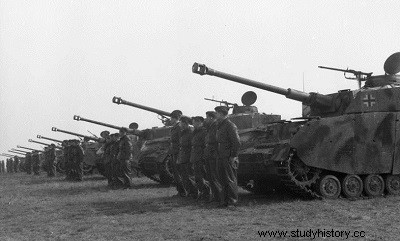
The first German armored divisions were organized around a brigade made up of two tank regiments, each regiment being made up of two battalions, for a total of 16 companies and 561 tanks. The extremist concept of "all armoured" was never accepted by Guderian, which made the Panzerdivision (Pz.D) a large combined arms unit, very flexible to use in operations and by no means confined to the roles of exploitation of success and of pursuit.
At the declaration of war, each Panzerdivision was reinforced by a fourth infantry battalion, while the tank battalions were reorganized on the basis of a company of medium tanks and two of light tanks.
In 1941, the Pz.D had a single tank regiment with three battalions for the first six, and two battalions for the fourteen others. The mechanized infantry brigades had six battalions each, and the artillery regiment had been reinforced with a third group of 105 mm and an anti-aircraft unit.
The armor/infantry ratio s It was therefore now reversed since 1935, due to the lack of resources in armored vehicles and their growing complexity. From 1942, the number of Pz.Ds was increased to twenty-five, but with actual numbers that varied greatly from one to another.
In the meantime, the battalion of motorcyclists had been abolished, while brigade headquarters and tank companies had returned to their pre-war numbers, at least on paper.
In 1943, the proportion of armored units in the division grew with the transition to four battalions per regiment, while the equipment in half-tracked armored vehicles of the infantry battalions renamed Panzergrenadieren became widespread. Another innovation was the allocation of 105 mm and 149 mm self-propelled guns, parallel to the establishment of the first battalions of Tiger and Panther tanks, and special engineering vehicles.
In reality , in spite of their qualitative progress, almost all the Pz.D suffered until the end of chronic deficits compared to their tables of manpower and endowment, deficits to be imputed in particular to the dispersion of the tanks and assault guns that led in 1943 to the creation of the Panzergrenadiere divisions. Another cause of the deficit was the transformation into Panzerdivisionen, in the same year, of the eight Panzergrenadiere divisions of the Waffen-SS.
